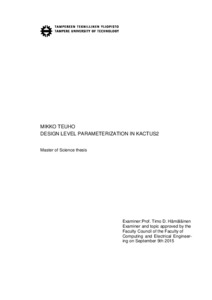Design level parameterization in Kactus2
Teuho, Mikko (2015)
Teuho, Mikko
2015
Tietotekniikan koulutusohjelma
Tieto- ja sähkötekniikan tiedekunta - Faculty of Computing and Electrical Engineering
This publication is copyrighted. You may download, display and print it for Your own personal use. Commercial use is prohibited.
Hyväksymispäivämäärä
2015-12-09
Julkaisun pysyvä osoite on
https://urn.fi/URN:NBN:fi:tty-201511241762
https://urn.fi/URN:NBN:fi:tty-201511241762
Tiivistelmä
Embedded systems are growing larger and more complex. Even now, current system designs can contain hundreds of Intellectual Property (IP) components. To keep up with productivity, the reusability of the IP components must be improved. This is the scope of IEEE standard IP-XACT.
This thesis is based on Kactus2, an open source IP-XACT tool developed at Tampere University of Technology. Kactus2 provides a graphical user interface for System-on-Chip and embedded system IP packing, design capture and VHDL/Verilog code generation.
This thesis describes the development and implementation of version 2.8 of Kactus2. The requirements and solutions are presented in detail for each of the new features and improvements implemented in version 2.8. Alternative solutions are presented, and the selected alternatives are justified. Possible future implementations are also given.
In version 2.8, the parameter usage of IP components is improved through the use of universally unique IDs (UUID), which requires many changes e.g. to the IP-XACT Component editors. New features include parameter importing, design level configuration through parameters and a parameter propagation mechanism. Remapping IP-XACT Memory Maps through the use of Remap States and memory Remap Elements has also been added. To facilitate the storing of hierarchical IP components, a new save action has been added to the Kactus2 toolbar.
Version 2.8 of Kactus2 was released according to its schedule. The development of the version is considered a success, as it improves the design level parameterization in Kactus2 while incorporating additional new features. Within a month of its release, Kactus2 version 2.8 has been downloaded over 200 times, and its benefits over the previous version are confirmed by industrial System-on-Chip developers.
This thesis is based on Kactus2, an open source IP-XACT tool developed at Tampere University of Technology. Kactus2 provides a graphical user interface for System-on-Chip and embedded system IP packing, design capture and VHDL/Verilog code generation.
This thesis describes the development and implementation of version 2.8 of Kactus2. The requirements and solutions are presented in detail for each of the new features and improvements implemented in version 2.8. Alternative solutions are presented, and the selected alternatives are justified. Possible future implementations are also given.
In version 2.8, the parameter usage of IP components is improved through the use of universally unique IDs (UUID), which requires many changes e.g. to the IP-XACT Component editors. New features include parameter importing, design level configuration through parameters and a parameter propagation mechanism. Remapping IP-XACT Memory Maps through the use of Remap States and memory Remap Elements has also been added. To facilitate the storing of hierarchical IP components, a new save action has been added to the Kactus2 toolbar.
Version 2.8 of Kactus2 was released according to its schedule. The development of the version is considered a success, as it improves the design level parameterization in Kactus2 while incorporating additional new features. Within a month of its release, Kactus2 version 2.8 has been downloaded over 200 times, and its benefits over the previous version are confirmed by industrial System-on-Chip developers.
